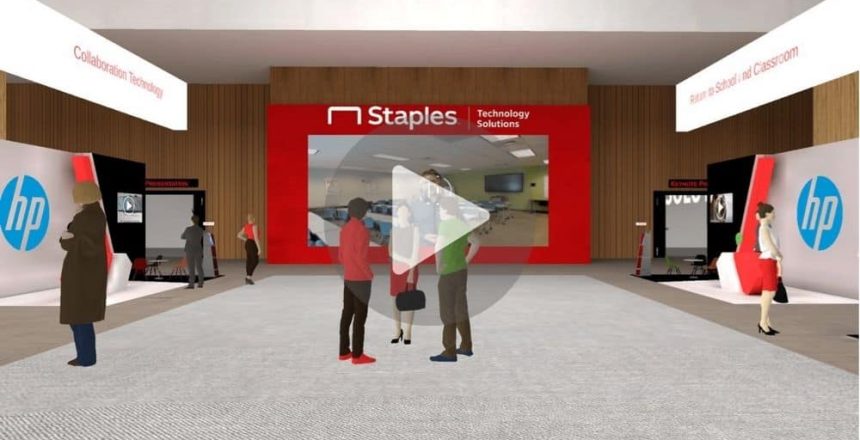Overview of the Project
To meet the demands of Staples Inc., one of the biggest office supply corporations in the world, Twin Reality created the Staples Virtual Expo, a cutting-edge virtual trade exhibition platform. The project’s goal was to simulate the typical in-person trade fair experience in a virtual setting, giving Staples and its vendors an immersive and interactive platform to present their goods, communicate with customers, and conduct business.
Who We Created This For and Their Issues
For Staples Inc. and its wide network of suppliers and clients, the Staples Virtual Expo was developed especially for them. With conventional in-person trade exhibitions, Staples encountered a number of difficulties, such as expensive venue rental costs, logistical issues, and participant travel charges. Furthermore, the COVID-19 epidemic made the necessity for a virtual substitute even more urgent as large-scale meetings were either severely curtailed or outright forbidden.
The business saw how virtual trade exhibitions could help them get over these obstacles and build a more effective and open platform for their vendors and clients. Staples required a system that would enable vendors to effectively market their goods, create meaningful connections with potential customers, and promote smooth business transactions, all while delivering an aesthetically pleasing and captivating experience.
Use Cases of the Project
- Virtual Booths and Product Showcases
Vendors can display their items with thorough explanations, high-resolution photos, and even 3D models at virtual booths provided by the Staples Virtual Expo. Visitors can explore the booths, see product demonstrations, and access in-depth product information, simulating the experience of walking through real exhibits at a conventional trade fair.
- Networking and Communication.
The networking functions included in the platform include live chat, video conferencing, and virtual meeting spaces. Attendees get the opportunity to converse with exhibitors in real time, ask questions about specific products, strike deals, and forge important business relationships.
- Seminars and Presentations.
Live panel discussions, webinars, and presentations can all be held at the virtual expo. With the use of this tool, exhibitors can demonstrate their skills, inform the audience about their goods or current business trends, and participate in interactive Q&A sessions with guests.
- E-commerce Integration.
With the platform’s seamless integration of e-commerce features, visitors may make purchases from inside the virtual expo setting. Vendors can provide special discounts, promotions, and package offers, making the purchasing process simple and quick.
Conclusion.
Staples Inc.’s difficulties with conventional trade exhibitions were successfully solved by Twin Reality’s creation of the Staples Virtual Expo. Staples and its vendors were able to reach a larger audience, successfully demonstrate items, and create lasting relationships with customers because to the platform’s use of virtual technology, which offered a less expensive, more convenient, and more interesting alternative to physical trade shows.
The project’s use cases included seamless e-commerce integration, networking and communication tools, virtual booths and product demonstrations, live seminars and presentations, and live seminars and presentations. Together, these innovations improved the entire trade show experience, resulting in higher levels of engagement, effectiveness, and revenue creation.
A look into the future of the sector is provided by the Staples Virtual Expo, which represents a paradigm shift in the way B2B trade exhibitions are organised. Twin Reality and Staples Inc.’s success has created a new benchmark for online trade show platforms, enabling other companies to embrace digital transformation and increase their reach in a field that is fast changing on a worldwide scale.

